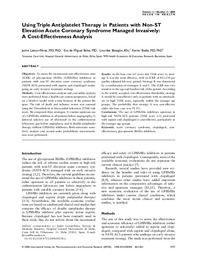Por favor, use este identificador para citar o enlazar este ítem:
https://hdl.handle.net/11000/34615Registro completo de metadatos
| Campo DC | Valor | Lengua/Idioma |
|---|---|---|
| dc.contributor.author | Latour-Perez, Jaime | - |
| dc.contributor.author | de Miguel Balsa, Eva | - |
| dc.contributor.author | Betegón, Lourdes | - |
| dc.contributor.author | Badia, Xavier | - |
| dc.contributor.other | Departamentos de la UMH::Medicina Clínica | es_ES |
| dc.date.accessioned | 2025-01-16T18:01:48Z | - |
| dc.date.available | 2025-01-16T18:01:48Z | - |
| dc.date.created | 2008 | - |
| dc.identifier.citation | Value Health. 2008 Sep-Oct;11(5):853-61 | es_ES |
| dc.identifier.issn | 1524-4733 | - |
| dc.identifier.issn | 1098-3015 | - |
| dc.identifier.uri | https://hdl.handle.net/11000/34615 | - |
| dc.description.abstract | Objectives: To assess the incremental cost-effectiveness ratio (ICER) of glycoprotein IIb/IIIa (GPIIb/IIIa) inhibitors in patients with non-ST elevation acute coronary syndrome (NSTE-ACS) pretreated with aspirin and clopidogrel undergoing an early invasive treatment strategy. Methods: Cost-effectiveness analysis and cost-utility analysis were performed from a health-care system perspective, based on a Markov model with a time horizon of the patient life span. The risk of death and ischemic events was assessed using the Thrombolysis in Myocardial Infarction (TIMI) risk score. We compared three strategies: 1) routine upstream use of a GPIIb/IIIa inhibitor to all patients before angiography, 2) deferred selective use of abciximab in the catheterization laboratory just before angioplasty, and 3) double antiplatelet therapy without GPIIb/IIIa inhibitors. Both univariate sensitivity analysis and second-order probabilistic microsimulation were performed. Results: In the base case (65 years old, TIMI score 3), strategy A was the most effective, with an ICER of €15,150 per quality-adjusted life-year gained. Strategy B was dominated by a combination of strategies A and C. The ICER was very sensitive to the age and baseline risk of the patient. According to the widely accepted cost-effectiveness thresholds, strategy A would be cost-effective only in patients with an intermediate to high TIMI score, especially within the younger age groups. The probability that strategy A was cost-effective under the base case was 91.2%. Conclusions: The use of GPIIb/IIIa inhibitors upstream in high-risk NSTE-ACS patients (TIMI score 3) pretreated with aspirin and clopidogrel is cost-effective, particularly in the younger age groups. Keywords: | es_ES |
| dc.format | application/pdf | es_ES |
| dc.format.extent | 9 | es_ES |
| dc.language.iso | eng | es_ES |
| dc.publisher | Malden, MA : Blackwell Science; Elsevier | es_ES |
| dc.rights | info:eu-repo/semantics/openAccess | es_ES |
| dc.rights | Attribution-NonCommercial-NoDerivatives 4.0 Internacional | * |
| dc.rights.uri | http://creativecommons.org/licenses/by-nc-nd/4.0/ | * |
| dc.subject | acute coronary syndrome | es_ES |
| dc.subject | clopidogrel | es_ES |
| dc.subject | costeffectiveness | es_ES |
| dc.subject | glycoprotein IIb/IIIa inhibitors | es_ES |
| dc.title | Using Triple Antiplatelet Therapy in Patients with Non-ST Elevation Acute Coronary Syndrome Managed Invasively A Cost-Effectiveness Analysis | es_ES |
| dc.type | info:eu-repo/semantics/article | es_ES |
| dc.relation.publisherversion | 10.1111/j.1524-4733.2008.00338.x | es_ES |

Ver/Abrir:
Using Triple Antiplatelet Therapy in Patients with....pdf
228,71 kB
Adobe PDF
Compartir:
 La licencia se describe como: Atribución-NonComercial-NoDerivada 4.0 Internacional.
La licencia se describe como: Atribución-NonComercial-NoDerivada 4.0 Internacional.
.png)